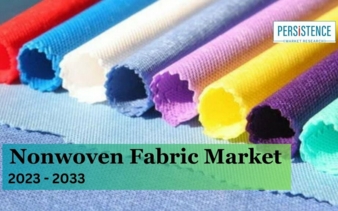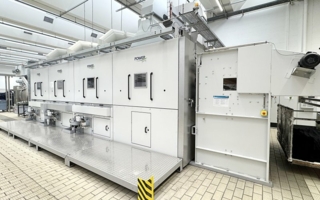03/04/2024 – Persistence Market Research
Nonwoven fabric market
Nonwoven fabrics, versatile materials made from fibers bonded together through various processes, find applications across industries such as healthcare, hygiene, automotive, construction, and agriculture. The global nonwoven fabric market exhibits robust growth, driven by technological advancements, increasing demand for sustainable alternatives, and expanding applications across diverse sectors, according to a report published by Persistence Market Research. Projections indicate a steady Compound Annual Growth Rate (CAGR) of 6.1%, with the market value expected to surpass US$ 86.2b by 2033.
The nonwoven fabric market has witnessed significant growth in recent years, driven by technological advancements, increasing demand from various end-use industries, and shifting consumer preferences towards sustainable and eco-friendly materials.
Technological innovations driving market growth
In recent years, technological innovations have revolutionized the nonwoven fabric manufacturing process, enhancing product quality, performance, and efficiency. Advancements in polymer science, fiber processing techniques, and machinery have played a crucial role in expanding the capabilities of nonwoven fabrics. Some key technological innovations driving market growth include:
– Spunbond technology: spunbond nonwoven fabrics are produced by extruding continuous filaments of thermoplastic polymers and then bonding them together. Recent innovations in spinning techniques, such as multi-beam and bicomponent spinning, have enabled manufacturers to produce nonwovens with improved strength, uniformity, and softness.
– Meltblown technology: meltblown nonwovens are manufactured by extruding molten thermoplastic polymers through fine nozzles and then rapidly cooling and solidifying the fibers to form a web. Advancements in meltblown technology have led to the development of ultrafine fibers, enabling the production of nonwovens with superior filtration properties for applications in healthcare, personal protective equipment (PPE), and air filtration.
– Composite technologies: composite nonwoven fabrics, combining multiple layers or types of fibers, have gained popularity due to their enhanced performance characteristics. Innovations in composite technologies have led to the development of nonwovens with tailored properties such as breathability, absorbency, and barrier properties, making them suitable for diverse applications in hygiene products, medical textiles, and geotextiles.
– Sustainable solutions: with growing environmental concerns, there is a rising demand for sustainable nonwoven fabrics made from renewable or recycled materials. Innovations in green chemistry, bio-based polymers, and recycling technologies have enabled manufacturers to produce eco-friendly nonwovens with reduced carbon footprint and enhanced biodegradability.
Increasing demand from end-use industries
The nonwoven fabric market is experiencing robust demand from various end-use industries, driven by their superior properties and cost-effectiveness compared to traditional textiles. Some of the key sectors fueling market growth include:
– Hygiene and personal care: nonwoven fabrics are extensively used in hygiene products such as baby diapers, feminine hygiene products, and adult incontinence pads due to their softness, absorbency, and fluid management properties. The growing global population, increasing awareness about personal hygiene, and rising disposable incomes are driving the demand for nonwoven-based hygiene products.
– Medical and healthcare: nonwoven medical textiles, including surgical gowns, masks, drapes, and wound dressings, are witnessing high demand, especially in light of the COVID-19 pandemic. The emphasis on infection control, healthcare infrastructure development, and rising healthcare expenditures are driving the adoption of nonwoven materials in the medical sector.
– Automotive: nonwoven fabrics are widely used in automotive interiors, filtration systems, and under-the-hood applications due to their lightweight, noise reduction, and thermal insulation properties. With the growing automotive industry, particularly in emerging economies, there is a rising demand for nonwoven materials to enhance vehicle comfort, safety, and performance.
– Construction and geotextiles: nonwoven geotextiles find applications in civil engineering projects such as road construction, drainage systems, and erosion control due to their high tensile strength, puncture resistance, and filtration properties. The increasing infrastructure development activities, urbanization, and environmental regulations are driving the demand for nonwoven geotextiles globally.
– Packaging and filtration: nonwoven fabrics are used in various packaging applications such as shopping bags, protective packaging, and agricultural covers due to their lightweight, tear resistance, and moisture barrier properties. Additionally, nonwovens are employed in industrial filtration applications for air, liquid, and gas filtration due to their high efficiency and contaminant retention capabilities.
Shifting consumer preferences and market trends
The nonwoven fabric market is evolving rapidly, driven by technological advancements and shifting consumer preferences. Key trends include sustainability, performance enhancement, digialization, and market consolidation. Manufacturers are innovating to meet demand for eco-friendly materials and customized solutions. Strategic partnerships and industry 4.0 technologies are expected to shape the market´s future trajectory, offering opportunities for growth and innovation in the global nonwoven fabric industry.




